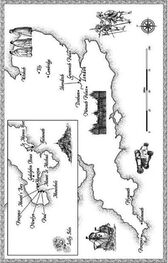Satan ordered them to take a cat, pass it nine times across a fire, then put to sea in sieves. They were to cast the cat into the sea, a sort of demonic baptism. This would raise a storm to sink the King’s ship. Their plan did not, of course, succeed.
On their return to land, they marched back to the church, led by Gellie Duncan, who played a reel on her Jew’s harp — a small, lyre-shaped instrument played against the teeth. They walked three times around the church, against the passage of the sun, then Dr Fian blew into the locked keyhole of the church and the door burst open. The church was in darkness, so he blew on the candles and they immediately lit.
The devil was waiting for them. He conducted a satanic service, then put his tail over the pulpit and made the witches kiss his buttocks. His followers then went outside where they feasted on dead bodies from the graveyard, before having a last dance, accompanied again by Gellie, who sang ‘ Kimmer, go you before, kimmer go you. If you will not go before, kimmer let me.’
At their trials, the alleged witches were accused of a number of crimes, including plotting against the King, burning his wax effigy, foretelling deaths, casting revenge spells against neighbours, being transported by the devil to foreign lands, keeping moles’ feet as charms, and dismembering the corpses of unbaptised children.
King James was particularly interested in the fates of Gellie Duncan, Agnes Sampson and Barbara Napier. He had Gellie brought to his palace of Holyrood House and made her play the tune which she had performed for the witches. He also had Agnes brought to him and questioned her at length.
At first he did not believe her tale, but then she asked to be allowed to approach him. She whispered in his ear words which had passed between him and his new queen on their wedding night in Oslo, when they were alone. The King was convinced by what he heard, ‘and swore by the living God that he believed all the devils in hell could not have discovered the same’.
He was in no mood for forgiveness. Over the winter and spring of 1590-1, Gellie and Dr Fian and many others were taken to Castle Hill in Edinburgh and burned at the stake. Then in April 1591, another highly political element entered the reckoning. Agnes Sampson accused the King’s heir — his cousin, the Earl of Bothwell — of sanctioning the assassination plot and of being linked to the accused witch Barbara Napier. Bothwell was arrested, but escaped and continued to cause James problems for many years to come before going into exile. Barbara Napier’s fate is less certain. She claimed to be pregnant to avoid the death penalty. James was incensed. He ordered his Lord Chancellor, John Maitland, to have her examined by physicians to see whether she was telling the truth or not. ‘Take no delaying answer,’ he demanded. ‘If you find she be not [pregnant], to the fire with her presently.’ He also insisted she be publicly disembowelled.
The jury had other ideas — and refused to have her sentenced to death. It was a small act of humanity, but the terror was far from over. Witchcraft trials and burnings in Scotland would last for many more years.
A modern audience can sometimes find it difficult to relate to a world where ordinary women — and they were mostly women — should be tortured and then killed in the most horrible way for what seems to be an imaginary crime. But to most Elizabethans (though not all, for plenty of people were sceptical), the crime was all too real.
In The Book of English Magic (2009), authors Philip Carr-Gomm and Richard Heygate estimate that up to 2,500 witches were burnt at the stake in Scotland between the fifteenth and seventeenth centuries. Up to five hundred were hanged in England during the same period.
The most high profile case in England during Elizabeth’s reign was the Witches of Warboys saga (Warboys is a fenland village in Huntingdonshire). An old woman named Alice Samuel, her husband John and their daughter Agnes were convicted of killing Lady Susan Cromwell (grandmother of Oliver Cromwell of Civil War fame) by enchantment and casting a spell to harm the children of local Huntingdonshire landowner Robert Throckmorton. All three members of the Samuel family were hanged in April 1593. They had been condemned to death under the Witchraft Act of 1562, which made sorcery a capital felony.
Even if witch-finding fervour never reached the same heights in England as in Scotland, the public was still fascinated — and terrified — by the subject, a fact not lost on Will Shakespeare. He would have heard lurid tales of the Scottish trials and would have known of King James’s keen interest in witchcraft. In Macbeth, which was performed before James (by then, King James I of England) the first witch says, ‘in a sieve I’ll thither sail’ — a line clearly inspired by Agnes Sampson’s confession of putting to sea in sieves to sink the King’s ship.







